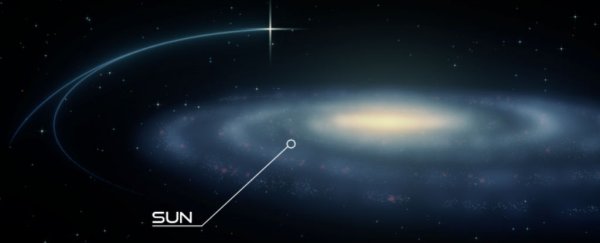Thousands of light-years away, on the outskirts of the Milky Way, astronomers have detected something no one's ever seen before - a binary star (two stars orbiting a common centre of mass) that's moving so fast, it's clocked speeds that almost rival the escape velocity of our galaxy.
What does that mean? Something must be helping this star system gather such incredible momentum, and until now, the best explanation we had for hyper-velocity stars is that they were being propelled by the supermassive black holes that lurk in the centre of a galaxy. But here's the thing: this binary star is nowhere near a supermassive black hole.
Named PB3877, and located about 18,000 light-years away from Earth, this binary star is not the first hyper-velocity star we've found in our galaxy. Astronomers have so far identified more than 20 hyper-velocity stars that seem hell-bent on getting the eff out of our cosmic neighbourhood.
One such hyper-velocity star is US 708, which was confirmed in 2005 to be hurtling through the Milky Way at about 745 miles per second (that's 1,198 km per second, or 2.7 million miles per hour) - fast enough to escape the gravitational pull of the galaxy.
"At that speed you could travel from Earth to the Moon in 5 minutes," said one of the researchers who found US 708, Eugene Magnier from the University of Hawaii. US 708 is expected to leave the Milky Way in about 25 million years.
But all other hyper-velocity stars we've found up till this moment have been single stars. This is the first time astronomers have found a double-star system that's achieved hyper-velocity speeds.
"We studied hyper-velocity stars since 2005, the year of discovery of the first three," said one of the researchers behind the discovery, Ulrich Heber from the Friedrich Alexander University in Germany. "In the meantime about two dozen have been found, but all are single, none has a companion directly visible in its spectrum."
The fact that PB3877 is zooming through the outskirts of the Milky Way is another thing that sets it apart from anything else astronomers have found. All the other hyper-velocity stars we know about have been relatively close to the supermassive black hole at the centre of our galaxy, and physicists have generally agreed that that's how their incredible acceleration rates could be explained.
Now we have something that puts this hypothesis into serious question.
PB3877 was first identified by researchers using data from the Sloan Digital Sky-Survey (SDSS) data in 2011, but back then, they thought it was a single star. Now, thanks to new observations made with the 10-metre Keck II telescope in Hawaii and the 8.2-metre Very Large Telescope (VLT) in Chile, the team in Germany was able to confirm that it was both a hyper-velocity star, and a binary system.
It appears to consist of one super-hot star that's more than five times hotter than our Sun, and a companion that's 1,000 degrees cooler than our Sun.
"When we looked at the new data, much to our surprise, we found weak absorption lines that could not come from the hot star," says astronomer Thomas Kupfer from the California Institute of Technology. "The cool companion, just like the hot primary, shows a high radial velocity. Hence, the two stars form a binary system, which is the first hyper-velocity wide binary candidate."
They also managed to map out its path to determine that it could not have originated from the centre of the Milky Way. This means it cannot have been accelerated by a supermassive black hole.
"From our calculations we can exclude the galactic centre as the place of origin, because its trajectory never came close to it," said team member Eva Ziegerer. "Other ejection mechanisms, such as stellar collisions and a supernova explosion, have been proposed, but all of them would lead to the disruption of a wide binary."
Instead, the team hypothesises that either a crapload of dark matter must be surrounding the star like a kind of 'halo' to keep it stable at such incredible speeds at the edge of the galaxy, or PB3877 could be an intergalactic 'intruder', formed in a neighbouring galaxy before infiltrating ours. It's not clear whether it will eventually make it outside the Milky Way.
"We used different mass models to calculate the probability that the star will actually remain bound to the galaxy. Only for the most massive galaxy model this is the case," said one of the researchers, Andreas Irrgang from the Dr Karl Remeis-Observatory in Germany. "This makes PB3877 an excellent target to probe dark matter halo models."
The findings have been published in the Astrophysical Journal Letters, and according to the team, the mere existence of this binary system puts pressure on accepted models and our current understanding of dark matter in the Milky Way. Somebody tell Stephen Hawking to get his spacecraft out there to give us a better look.
